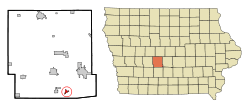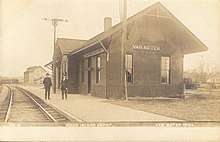Van Meter, Iowa
Van Meter is a city in Dallas County, Iowa, United States, situated along the Raccoon River. The population was 1,016 at the 2010 census,[5] with an estimated population in 2018 of 1,181.[6] Van Meter is part of the Des Moines–West Des Moines Metropolitan Statistical Area.
Van Meter, Iowa | |
|---|---|
| Motto(s): "Tradition with a Vision"[1] | |
 Location of Van Meter, Iowa | |
| Coordinates: 41°31′53″N 93°57′19″W | |
| Country | |
| State | |
| County | Dallas |
| Area | |
| • Total | 2.34 sq mi (6.06 km2) |
| • Land | 2.32 sq mi (6.00 km2) |
| • Water | 0.02 sq mi (0.06 km2) |
| Elevation | 873 ft (266 m) |
| Population | |
| • Total | 1,016 |
| • Estimate (2019)[4] | 1,292 |
| • Density | 557.62/sq mi (215.27/km2) |
| Time zone | UTC-6 (Central (CST)) |
| • Summer (DST) | UTC-5 (CDT) |
| ZIP code | 50261 |
| Area code(s) | 515 Exchange: 996 |
| FIPS code | 19-80445 |
| GNIS feature ID | 0462534 |
| Website | www |
History
Van Meter was laid out as a town in 1869.[7] The city was named for Jacob Rhodes Van Meter and his family, Dutch settlers from Meteren, the Netherlands.[8] Van Meter was incorporated on December 29, 1877.[9]

The Van Meter Visitor
In September and October 1903, there were multiple instances of people claiming to have seen a winged, bat-like creature in and around Van Meter. The roughly nine-foot tall being, which has since been dubbed the "Van Meter Visitor", was reported to be able to shoot light from the horn situated on its forehead, and be unaffected by bullets. Clarence Dunn, one of the witnesses, had even made a plaster cast of three-toed footprints it left behind. It was sometimes accompanied by a smaller, similar being. After a community-led confrontation, the being disappeared after about four days, supposedly into the nearby coal mine.[10][11] Claims of witnessing bat-like creatures or phenomena have continued, including into the 2010s.[12]
To commemorate the sightings, a Van Meter Visitor Festival transpires annually around the anniversary of the events.[13][12]
Geography
Van Meter's longitude and latitude coordinates in decimal form are 41.531505, -93.955338).[14]
According to the United States Census Bureau, the city has a total area of 1.30 square miles (3.37 km2), of which 1.28 square miles (3.32 km2) is land and 0.02 square miles (0.05 km2) is water.[15]
Van Meter is situated west of Des Moines, just south of Interstate 80.
Demographics
| Year | Pop. | ±% |
|---|---|---|
| 1880 | 376 | — |
| 1890 | 467 | +24.2% |
| 1900 | 407 | −12.8% |
| 1910 | 386 | −5.2% |
| 1920 | 358 | −7.3% |
| 1930 | 400 | +11.7% |
| 1940 | 436 | +9.0% |
| 1950 | 364 | −16.5% |
| 1960 | 385 | +5.8% |
| 1970 | 464 | +20.5% |
| 1980 | 747 | +61.0% |
| 1990 | 751 | +0.5% |
| 2000 | 866 | +15.3% |
| 2010 | 1,016 | +17.3% |
| 2019 | 1,292 | +27.2% |
| Source:"U.S. Census website". United States Census Bureau. Retrieved 2015-10-26. and Iowa Data Center Source: | ||
2010 census
As of the census[3] of 2010, there were 1,016 people, 382 households, and 280 families residing in the city. The population density was 793.8 inhabitants per square mile (306.5/km2). There were 415 housing units at an average density of 324.2 per square mile (125.2/km2). The racial makeup of the city was 97.9% White, 0.2% African American, 0.2% Native American, 0.6% Asian, and 1.1% from two or more races. Hispanic or Latino of any race were 0.6% of the population.
There were 382 households of which 45.8% had children under the age of 18 living with them, 51.3% were married couples living together, 14.4% had a female householder with no husband present, 7.6% had a male householder with no wife present, and 26.7% were non-families. 22.3% of all households were made up of individuals and 6.8% had someone living alone who was 65 years of age or older. The average household size was 2.66 and the average family size was 3.09.
The median age in the city was 35.5 years. 31.7% of residents were under the age of 18; 5.9% were between the ages of 18 and 24; 27.4% were from 25 to 44; 26.4% were from 45 to 64; and 8.7% were 65 years of age or older. The gender makeup of the city was 49.5% male and 50.5% female.
2000 census
As of the census[17] of 2000, there were 866 people, 326 households, and 237 families residing in the city. The population density was 1,450.3 people per square mile (557.3/km2). There were 342 housing units at an average density of 572.8 per square mile (220.1/km2). The racial makeup of the city was 98.15% White, 0.23% African American, 0.69% Asian, 0.23% Pacific Islander, 0.23% from other races, and 0.46% from two or more races. Hispanic or Latino of any race were 1.39% of the population.
There were 326 households out of which 41.1% had children under the age of 18 living with them, 59.2% were married couples living together, 11.3% had a female householder with no husband present, and 27.0% were non-families. 20.9% of all households were made up of individuals and 3.7% had someone living alone who was 65 years of age or older. The average household size was 2.66 and the average family size was 3.13.
In the city, the population was spread out with 30.5% under the age of 18, 6.8% from 18 to 24, 33.4% from 25 to 44, 21.4% from 45 to 64, and 8.0% who were 65 years of age or older. The median age was 35 years. For every 100 females, there were 92.0 males. For every 100 females age 18 and over, there were 88.1 males.
The median income for a household in the city was $50,625, and the median income for a family was $59,000. Males had a median income of $37,895 versus $26,023 for females. The per capita income for the city was $20,272. About 0.8% of families and 2.7% of the population were below the poverty line, including none of those under age 18 and 6.4% of those age 65 or over.
Arts and culture
The Bob Feller Museum opened on June 10, 1995, in honor of Bob Feller, a National Baseball Hall of Fame pitcher and a native of Van Meter.
On November 11, 2006, Veterans Day, ground was broken for an Iowa Veterans Cemetery at a site located near Van Meter. Iowa Governor Tom Vilsack was among those who helped dedicate the cemetery.
Notable people
- Myrtle Aydelotte, nurse, professor, and hospital administrator
- Derek Benz, science fiction author, The Revenge of the Shadow King.
- Bob Feller, Major League Baseball pitcher and member of Baseball Hall of Fame; born in Van Meter
- David Young, former U.S. Representative for Iowa's 3rd congressional district
References
- "City of Van Meter, Iowa". City of Van Meter, Iowa. Retrieved August 31, 2012.
- "2019 U.S. Gazetteer Files". United States Census Bureau. Retrieved July 17, 2020.
- "U.S. Census website". United States Census Bureau. Retrieved 2012-05-11.
- "Population and Housing Unit Estimates". United States Census Bureau. May 24, 2020. Retrieved May 27, 2020.
- "Geographic Identifiers: 2010 Demographic Profile Data (G001): Van Meter city, Iowa". U.S. Census Bureau, American Factfinder. Retrieved October 26, 2015.
- "Population and Housing Unit Estimates". Retrieved February 18, 2020.
- The History of Dallas County, Iowa: Containing a History of the County, Its Cities, Towns, &c. Higginson Book Company. 1879. pp. 483.
- "Profile for Van Meter, Iowa, IA". ePodunk. Retrieved August 31, 2012.
- "Van Meter, Iowa". City-Data,com. Retrieved August 31, 2012.
- Kilen, Mile (July 1, 2015). "Van Meter remembers 1903 visit from winged monster". Des Moines Register. Retrieved December 8, 2019.
- Lewis, Chad; Nelson, Kevin Lee; Voss, Noah (2013). The Van Meter Visitor: A True and Mysterious Encounter with the Unknown. On the Road Publishing. ISBN 0982431465.
- Cole, Clint (October 2, 2017). "Van Meter Visitor festival keeps the hunt alive". Adel News. Retrieved December 8, 2019.
- "Van Meter Visitor Festival". Travel Iowa. Retrieved December 8, 2019.
- "US Gazetteer files: 2010, 2000, and 1990". United States Census Bureau. 2011-02-12. Retrieved 2011-04-23.
- "US Gazetteer files 2010". United States Census Bureau. Archived from the original on 2012-01-25. Retrieved 2012-05-11.
- "Census of Population and Housing". Census.gov. Retrieved June 4, 2015.
- "U.S. Census website". United States Census Bureau. Retrieved 2008-01-31.